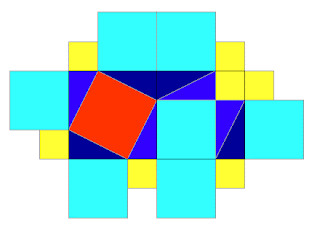As shown in the graph above, it's called a consequence of the Pythagorean theorem: The length of the diagonal of a square is the square root of two times its side. The length of the square is a rational number while the length of diagonal is irrational. While we can just keep getting the 1/2 of the existing square to get infinitely many rational numbers, these natural numbers are countably many. But the number of irrationals are far more than the rationals, which is illustrated by the cardinality of the rationals and irrationals. |R\Q| >|Q|.
Now here is a trick to show why there are more irrationals than rationals.
We do this by trying to list all the real numbers in the interval (0,1).
First, because each of the rational numbers can be associated with a natural number by listing there like below.
In this way, each number is followed by its negative version, except zero, which doesn't have a different negative version. he fractions, if considered as improper fractions, are ordered by the sum of the numerator and denominator, starting with the fraction with the largest numerator: thus, we go through 4/1, 3/2, 2/3,1/5 in order. (Earlier, 2/2 was omitted, since that equals 1, which is already on the list.)
N Q
1 1/1
2 -1
3 2/1
4 -2/1
5 1/2
6 -1/2
7 3
8 -3
9 1/3
10 -1/3
11 4
12 -4
... ...
Then we can use all the natural numbers to list all the rational numbers. We have |Q| = |N|
Now we are trying to show there are more irrational number than rationals by trying to list all the irrationals by natural numbers.
.27231364585...
.40861132064...
.01678396536...
.81171944218...
.82122547689...
.17218943291...
...
We are trying to list all the real numbers by associating each with a natural number. But it seems there are always at least 1 more irrational number than all the rational numbers that we can list. Assume we listed all the natural number with each there's a corresponding irrational number, we can get a new irrational numbers by picking up the irrational on the diagonal of the existing list.
Because the new number is attained by picking the jth digit of the decimal on jth row, so it's different from any of the existing irrationals.
Therefore there are more irrational numbers than natural numbers, thus there are more irrational numbers than rationals.

